Every business has to grow to stay relevant and competitive. But what growth means to one company can mean something completely different to another.
In this post, you’ll learn what business growth is, the different stages of growth, and some tips to expand sustainably.
What Is Business Growth?
Business growth refers to the point when a company must explore other options to generate profit. It involves the steps the business must take to reach the “next level” (whatever that level may be).
Growth is influenced by customer trends, new market opportunities, and decisions made by company leadership. It changes how you operate internally and how you market your product externally for the better.
No one metric defines growth. But an increase in any of the following metrics can help determine if your business is growing:
- Sales
- Revenue
- Profits
- Company value
- Number of customers
- Number of employees
You’ll likely measure one or more of these metrics as your main objective for moving your business forward.
Business growth puts you in a strong position to expand your products and services, boost sales, attract the best talent, appeal to investors, and take advantage of new opportunities.
The type of business growth strategy needed to enjoy these benefits depends on what stage your business is at in its journey (e.g., whether you’re starting out or established).
The 4 Stages of Business Growth
Every business goes through different stages of growth. This is known as the company life cycle.
And the product life cycle follows the same kind of rise and fall: introduction, growth, maturing, and decline.
The growth challenges you’ll face will differ depending on where your business sits on this timeline.
Let’s take a look at each stage.
1. Introduction Stage
This is the new business stage where your product or services have recently launched and your company is finding its footing. Sales may be low but are hopefully steadily increasing.
From a growth point-of-view, the main task at this stage is to build brand awareness so your business is visible to more potential customers.
People tend to buy from companies they know and trust. Your job is to attract attention and create familiarity. This can be done by delivering on what’s known as the 4Cs of marketing:
- Customer wants and needs. Show your target customers how your product or services solve their problems by clearly explaining what you offer and what problem your product can solve.
- Cost. Explain the total cost (e.g., price including shipping and handling) so that people know exactly how much they’ll pay. In other words, avoid hidden charges.
- Convenience. Make it as easy as possible for customers to buy your product or service. Can the customer easily find what they’re looking for on your website? Can they get from a product page to checkout in a few clicks? Are descriptions helpful enough?
For example, email marketing tool Campaign Monitor uses its blog content to cater to its ideal customers.
Before potential customers decide to make a purchase, they can learn about relevant email marketing topics on the blog—for free.
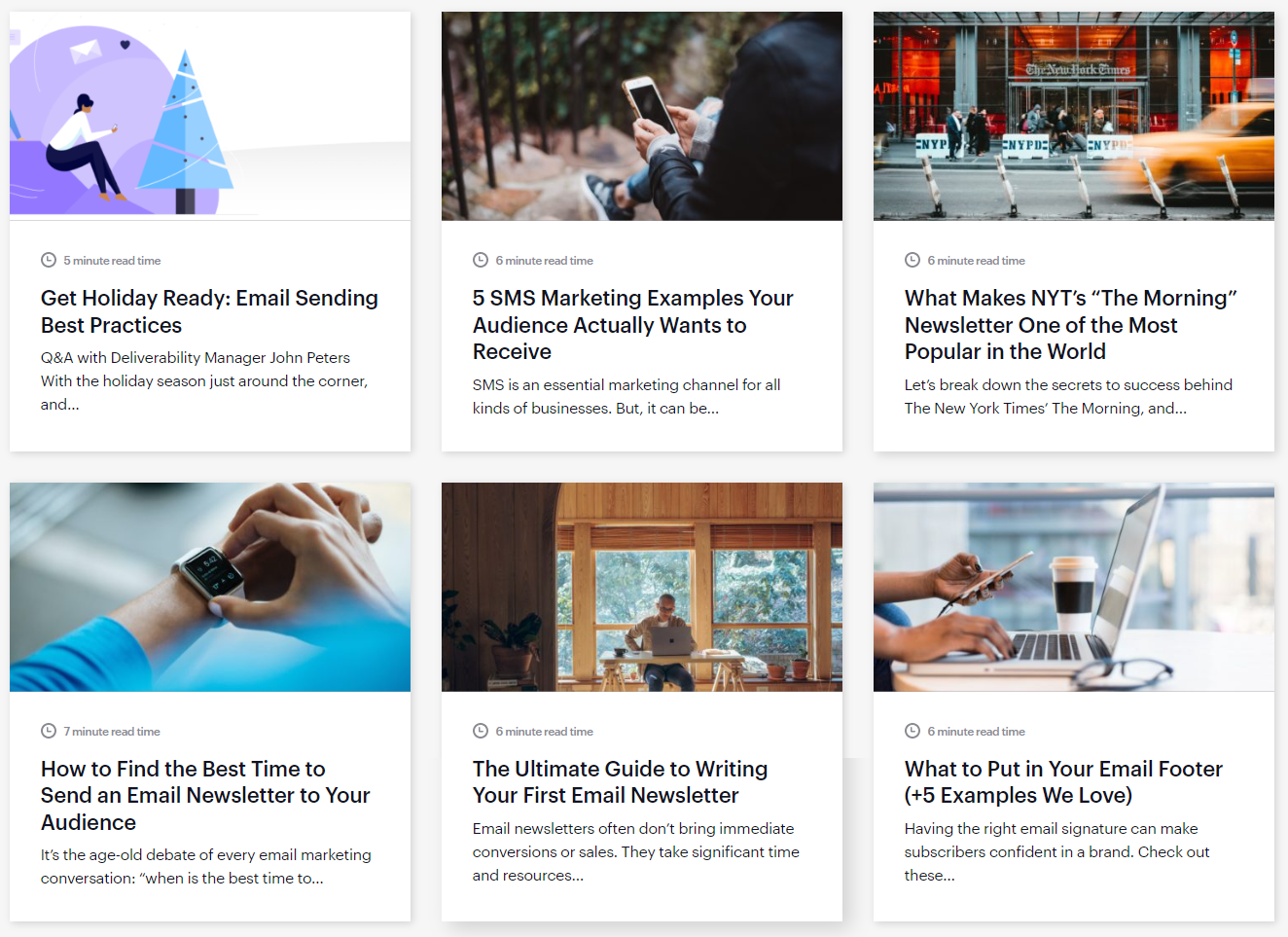
This helps the company position itself as a knowledgeable and valuable brand. And ideally, as the kind of company you’d want to do business with if you need an email marketing tool.
When that time comes, Campaign Monitor is open about pricing and helps people choose the right plan based on their list size:
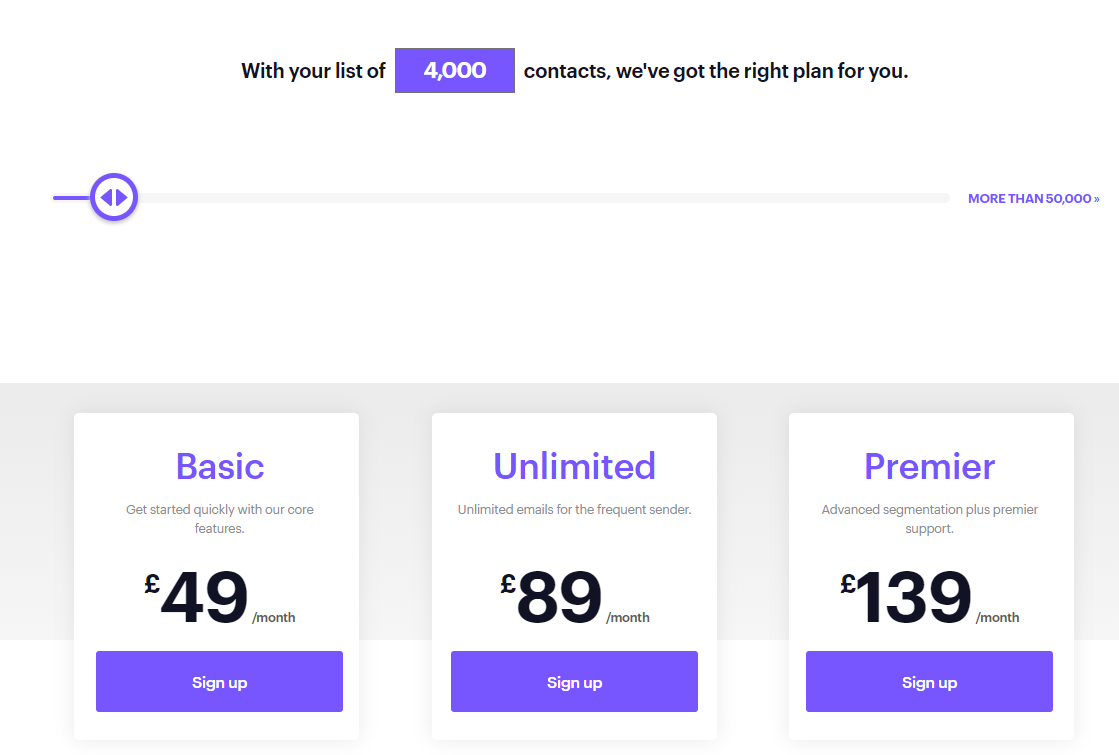
And when customers are confident the tool has what they need, getting started is as simple as clicking a button and completing a form:
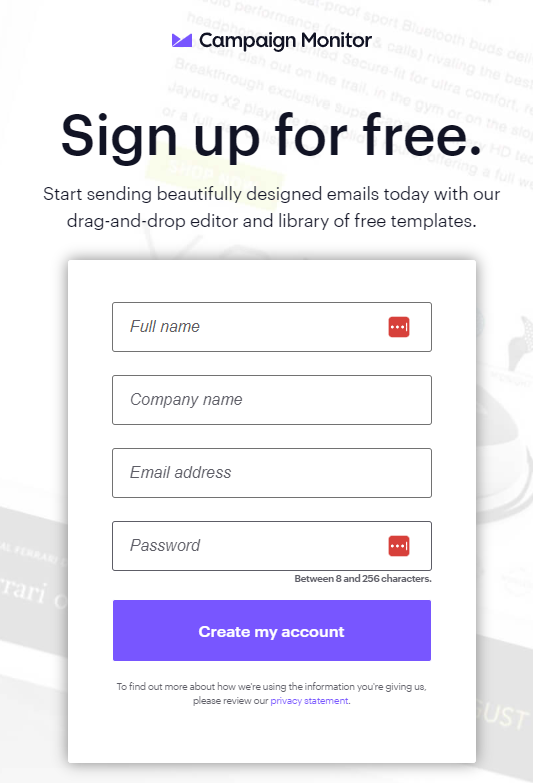
Everything is designed to make it as easy as possible for people to learn, choose, and buy without any “hard selling.” This allows customers to build up trust in their own time.
2. Growth Stage
In the growth stage, your initial marketing efforts are paying off and you’re noticing an increase in sales. This might result in better cash flow and profitability.
The challenge now is to increase your market share and become the brand of choice for customers.
In this phase, you have the advantage of existing customers. You can use their experiences to improve your messaging and customer experience.
For example, payment portal Wise uses Net Promoter Score (NPS) surveys to ask its customers how likely they are to recommend them to their friends on a scale of 1–10.
This research helped them find out that 67% of customers join Wise through a recommendation.
To keep this score up, Wise uses feedback to keep improving.
Our customers are at the heart of everything we do. We know that in order for every user to become an advocate for Wise, our product has to be worth talking about. We try to be 10x better and more exciting than the competition. Our goal is to create experiences and products our customers didn’t think were possible.
This keeps current customers happy, which makes them more likely to recommend Wise, helping grow the company through word of mouth.
3. Maturity Stage
In the maturity stage, your business is stable and income is more predictable. Customers are familiar with your brand and some have even become advocates.
The challenge now is to stay at the top by maintaining market share and combating the threat of new competitors entering the market.
This might require you to invest in innovation and bring in skilled staff to launch a new product line or features.
For example, when faced with the threat of new smartphone manufacturers, Apple innovated by creating the iPad.
You will also need to invest more in your brand. When your market gets crowded, differentiating on price and features becomes more difficult.
Other companies will likely try to sell similar products and services cheaper than yours. When this is the case, your brand becomes a deciding factor.
In other words, people choose your business because they know, trust, and like it.
Nike, for instance, is one of many sports companies that sell workout gear and running shoes. Its brand is its edge.
Nike knows that customers sometimes struggle for motivation. The company has built its brand around this, inspiring customers to “Just Do It.”
Nike’s brand successfully differentiates itself from other big players in the fitness industry. And as a mature company, Nike also keeps a pulse on the cultural moment. An example being football player Colin Kaepernick’s campaign in 2018.

4. Decline Stage
In the decline stage, product sales and profits start to shrink. Now, the task is to find future growth opportunities.
Decline and growth seem like opposites. But exploring ways to expand is crucial to your next product, service, or venture being successful.
Growth happens around new ideas and technologies. Use profits from the maturity stage to invest in research and development, come up with new products and services, find a new market, or explore a possible partnership with another company.
You might also look to reposition your brand to plot a new path forward.
For example, after suffering a drop in profits, fashion brand Gucci invested in a new CEO and creative director. They repositioned the company from a high-fashion brand with an aging customer base into a sought-after label for millennials.
By shifting focus to streetwear-inspired designs and investing in social media marketing, Gucci’s sales have continued to grow. The brand is one of the fastest growing on Instagram, with over 49 million followers.

Your stage in the business life cycle will influence your approach to growth.
Let’s identify which growth strategy may work best for your business.
4 Business Growth Categories
Business growth falls into four main categories: organic, strategic, internal, and external.
1. Organic Business Growth
Organic growth (also known as internal growth) means expanding your business from within, using your own money, capabilities, and resources. Growth strategies might include:
- Optimizing how you work to improve how products and services are priced, marketed, and sold (e.g. cutting down on wasted spend or improving workflow)
- Reallocating funds into more profitable activities to boost income and growth (e.g. investing more into marketing high-earning products or services)
- Creating new products and services to offer with materials you already have
Organic growth is an effective strategy for small businesses and startups, as it lets you grow sustainably and build on your strengths without taking on debt.
You also enjoy full control of ownership. Unlike a merger or external investment which could mean a loss of control or a shift in company culture.
The money earned through organic growth can be used in strategic growth strategies.
2. Strategic Business Growth
While organic growth looks at what you can do now to help expand your business, strategic growth looks at the future by developing strategies that will grow your business long-term.
External business growth plans might include:
- Targeting a new audience
- Launching a new marketing strategy
- Developing a new product
- Introducing new features
Take the small, local Edelweiss Bakery. After being in the business for 20 years, they wanted to increase their brand visibility online and in search engines to reach more potential customers.
With the help of an SEO agency, Edelweiss identified online marketing as a strategic approach to growth.
They increased organic search traffic by optimizing their website for SEO and ecommerce, as well as by creating relevant content.
The result? A 460% increase in mobile organic traffic to the bakery’s website and company growth. They also have solid foundations in place to reach new customers long-term.
The time, money, and resources that go into strategic growth mean that efforts should follow organic growth. This way, you can invest what you’ve earned to expand before deciding whether or not to seek external investment.
3. Internal Business Growth
Internal growth is about streamlining internal processes to increase revenue.
It sounds similar to organic growth, which also uses internal resources. But instead of focusing on production, internal growth strategies focus on using internal resources purposefully.
Internal growth forces you to look at your existing resources creatively. You don’t necessarily need to invest more time and money into growth. You need to reevaluate what you’re currently doing and how it can be more effective—and profitable.
Say you have a staff of full-time graphic designers. But they spend a lot of their salaried time on small, easy-to-create requests.
You might decide to hire a freelance designer so your full-time staff can tackle more complex projects that will have a bigger impact.
4. External Business Growth
External growth (also known as inorganic growth) is when your business partners with a similar business to achieve its growth strategy goals. Most commonly, this happens with a merger or acquisition.
A merger is when two or more businesses combine their companies to expand their reach and gain market share from competitors.
For example, food companies Heinz and Kraft Foods merged to form the Kraft Heinz Company to join forces and adapt to changing consumer demands.
An acquisition is when a more profitable company buys a large number of, or all, shares in another company to gain control.
Like when Dropbox acquired document sharing platform DocSend and e-signature provider HelloSign. This helped Dropbox give its customers a single destination to develop, share, and sign contracts.
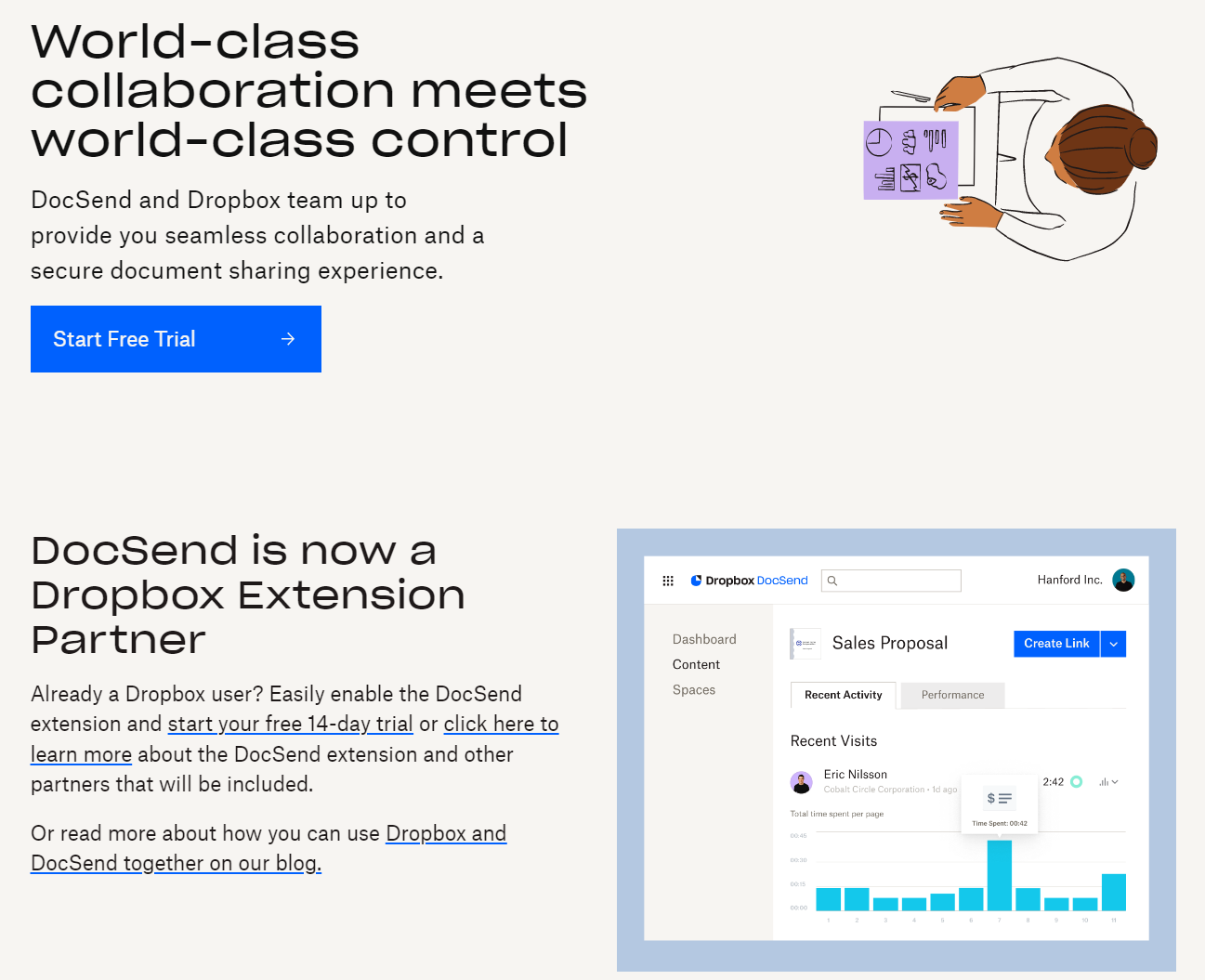
External growth gives you access to capital, expertise, and technology to:
- Break into new markets
- Improve products and services
- Access new channels to promote and distribute your products or services
- Enjoy the customer loyalty of another brand
- Benefit from intangible assets such as brand names, patents, and trademarks that can strengthen your position.
These advantages can be particularly beneficial in the maturity and decline phases of the business life cycle when you need to find new ways to stay ahead of the competition.
However, by committing to external growth, you’ll give up some control over how you run and grow your business.
A potential partner should match your company’s values and ambitions. Stakeholders and employees need to get along and work together effectively.
A deal should also benefit your customers, as Brad Cleveland of the International Customer Management Institute (ICMI) shares in Forbes:
How will this impact your customers? That is true north. And it’s more than just a question of ‘whether’ to proceed or not, but also ‘how’ you should move forward. What are your priorities to maintain and improve customer loyalty, market share, and brand advocates?
How to Grow your Business Sustainably and Effectively
Your finances and the stage of your business will inform what type of growth to pursue:
- Organic growth. Best if you’re a new business or startup in the introduction or growth stages.
- Strategic growth. Best if you’re a growing business with money to invest in long-term tactics to reach new customers and develop new products and services.
- External growth. Best if you run an established business and want to stay on top of your industry. Outside investment and expertise will help improve products or services and allow you to reach new target markets.
While your approach will differ with each growth type, there are some fundamental tasks that can help growth at every stage.
Conduct Market Research
Market research is the process of gathering information about your target audience. It helps you answer important questions about your audience, like:
- What are the demographics of the people who buy my product or services?
- What are their interests?
- What do they think about my business or industry?
- What problems can I help them solve?
- How can I connect with them?
Research is an important step to take before launching any new venture or product, or even before entering into a new market. It helps you figure out how companies market products and whether there’s demand so growth doesn’t fall flat.
Market research falls into two categories:
- Primary research. Tasks you can complete in-house, like surveying customers on how they feel about your business or industry. This includes market segmentation, or creating audience groups (by age, gender, location, income, interests, etc.).
- Secondary research. Research carried out by someone else that you can access, like industry statistics, analysis by trade magazines, and information collected by the government (e.g., census data and labor statistics).
The former drills down to help you find out how customers in your industry behave so your marketing resonates with them.
The latter gives you a big-picture insight into your industry and other competitors in the market (e.g., if the industry is in demand and predicted to grow).
The research category and methods you choose will depend on what you’re trying to understand.
For example, if you’re launching a new product, service, or business, research first needs to focus on market trends and opportunities.
But if you’re trying to figure out how to improve your marketing, your focus should be on customer problems and desires.
Here’s a breakdown of methods you can use to conduct your research based on your goals:
- For customer pain points: Interviews, focus groups, surveys, observational research, market segmentation and demographics
- For market trends and opportunities: competitive analysis, secondary market research data, focus groups, market segmentation and demographics
- For business performance: competitive analysis, interviews, focus groups, surveys
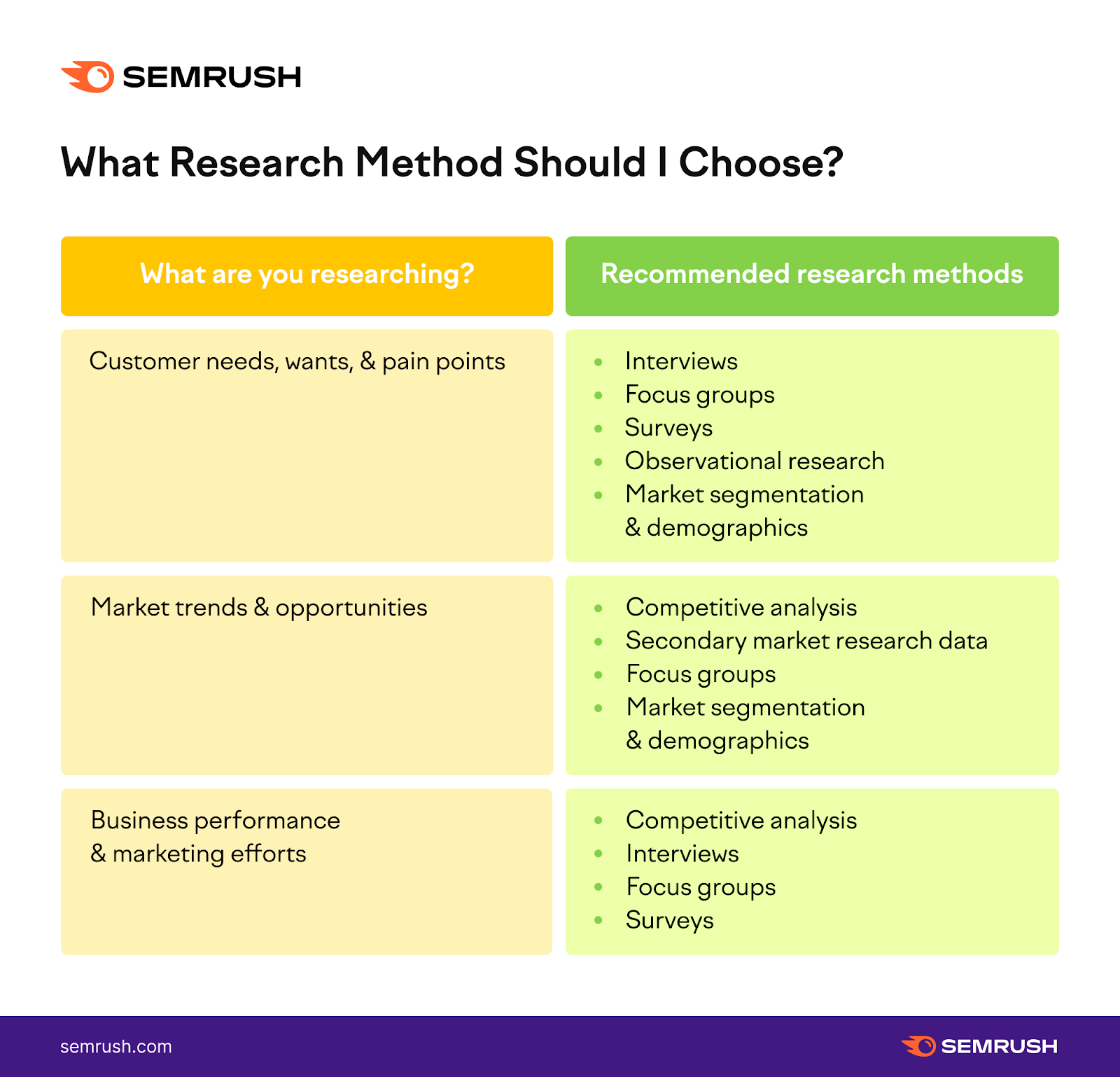
To gather information, follow our step-by-step guide to market research where you can walk through the research process.
Pro tip: You can also use a tool like Semrush’s Trends to analyze trends in your market.
Set Goals for Growth
Growth means different things at different times. That’s why, before doing anything else, it’s important to understand what you’re trying to grow.
For example, you might focus on:
- Growing sales
- Adding new products or services
- Growing your customer base
- Expanding into new locations
- Adding more space to your office or opening a new store
Growth might happen in more than one of these areas.
For example, if your sales grow, you might need more staff to meet demand and a larger space to accommodate them.
But to keep things simple, it’s best to start with one goal in mind. Plus a timeframe.
Once you have a specific goal, you can break it down into smaller tasks to make it more achievable.
For example, your five-year goal might be to:
- Reach $3 million in revenue
- Have 100 employees
- Have 100,000 active customers
Further break that down to find out how much you’d need to make each year in order to reach your end goal.
For example, you may need to make $1 million in sales by the end of year three. And $300,000 by the end of year one.
Let’s say it takes 2,000 customers to make $300,000 in sales. Then you know how many more customers you need to acquire in the next 12 months.
Use the SMART framework to make your goals realistic and achievable.
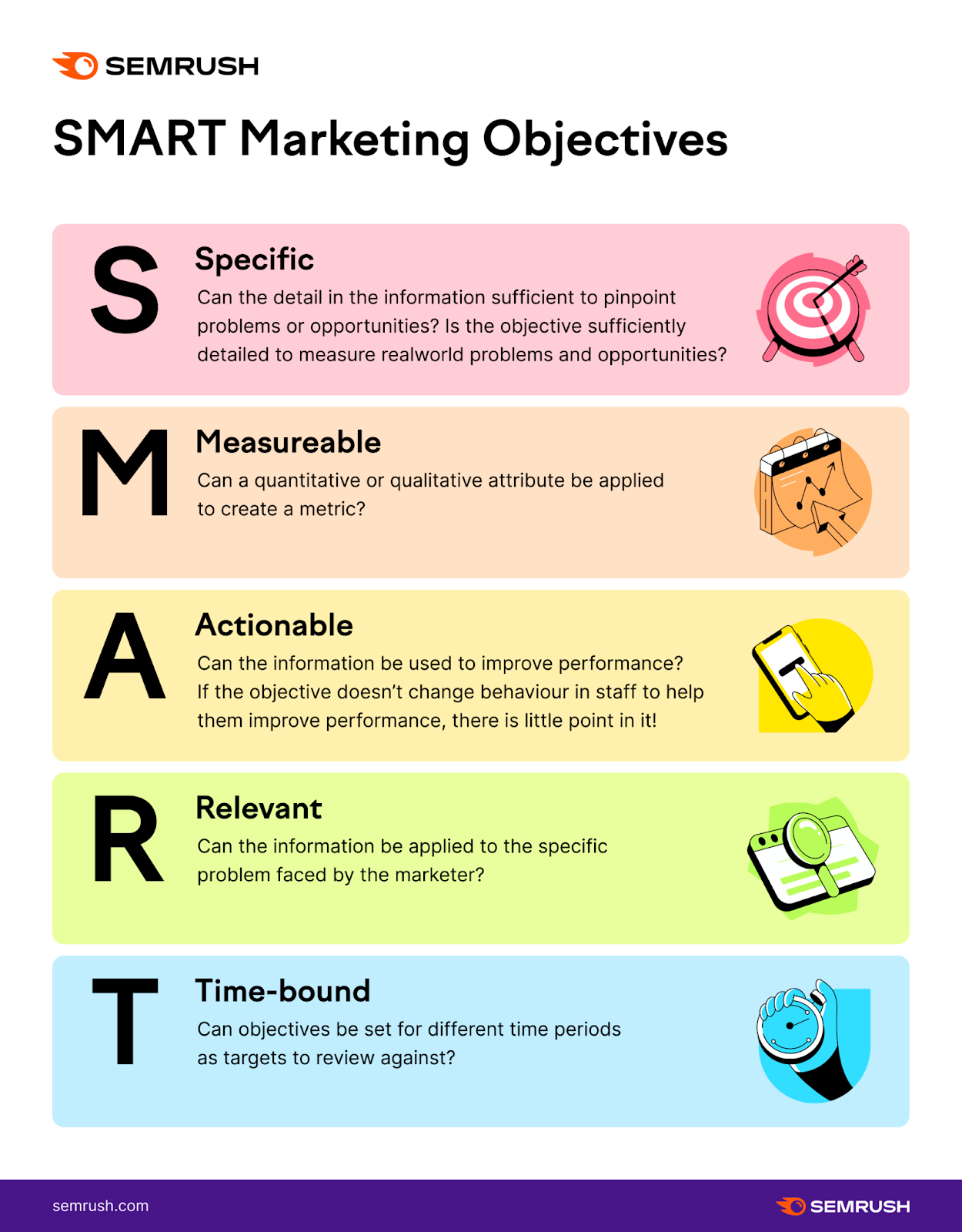
Following this framework gives your business goals structure. For example, a goal to “get more customers” becomes “get 1,200 new customers by the fourth quarter of this year.”
Having a clear goal keeps your business moving in the direction you want it to. It also gives you target milestones to reach on the way to meeting your five or 10-year targets.
Hire the Right People
According to entrepreneur, investor, and recruitment-expert James Caan, the key to success is hiring people better than you.
It can be a sign of strength in an individual to recognize when you are not good at something so you can bring someone in who is. I have always looked to take on the right people to perform in areas where I do not feel comfortable or have the necessary expertise to do the best possible job.
Of course, you should always ensure you are familiar with as much as possible. But nobody can be strong in every single aspect, so it makes sense to spread the workload.
Hiring the right people better equips your business for growth. Not only in the additional skills employees bring, but in their ability to help you free up time and collaborate to come up with new ideas.
Before hiring anyone, you need to know that you’re ready:
- Are there specific projects or goals you need help with?
- Do you have the funds to cover their salary?
- Do you have the time and resources to train and manage a new employee?
If you’re hiring for the first time, you’ll benefit most from employing a generalist rather than a specialist.
A generalist is someone who has particular skills but is capable of wearing different hats. For example, they might be great at marketing but able to move easily into pitching products or meeting with clients. Generalists let you cover more bases with fewer employees.
As your business grows, you can then look at bringing in specialists. A specialist is an expert in a specific area (e.g., advertising, project management, or product development) who can help take your business to the next level.
A specialist’s advanced knowledge will mean they’re able to complete tasks quicker and help train other team members if needed. However, they’ll also likely command a higher salary.
Be Ready to Adapt
A trait that many successful businesses share is the ability to adapt to changes in the market.
Adaptation involves changing your marketing strategy or business model to keep growing your business as your industry changes. This could mean introducing new products or services, or switching from retail stores to ecommerce.
Take Joyride Coffee. It began as a mobile cafe truck, but grew enough to open branches in New York, Los Angeles, Boston, and San Francisco.
Then when the COVID-19 pandemic hit, the company was unable to open its doors to serve customers, so it adapted.
Joyride introduced a delivery service on its website so customers could order coffee to their homes. They also launched a new product, Joyride Boxed Cold Brew.
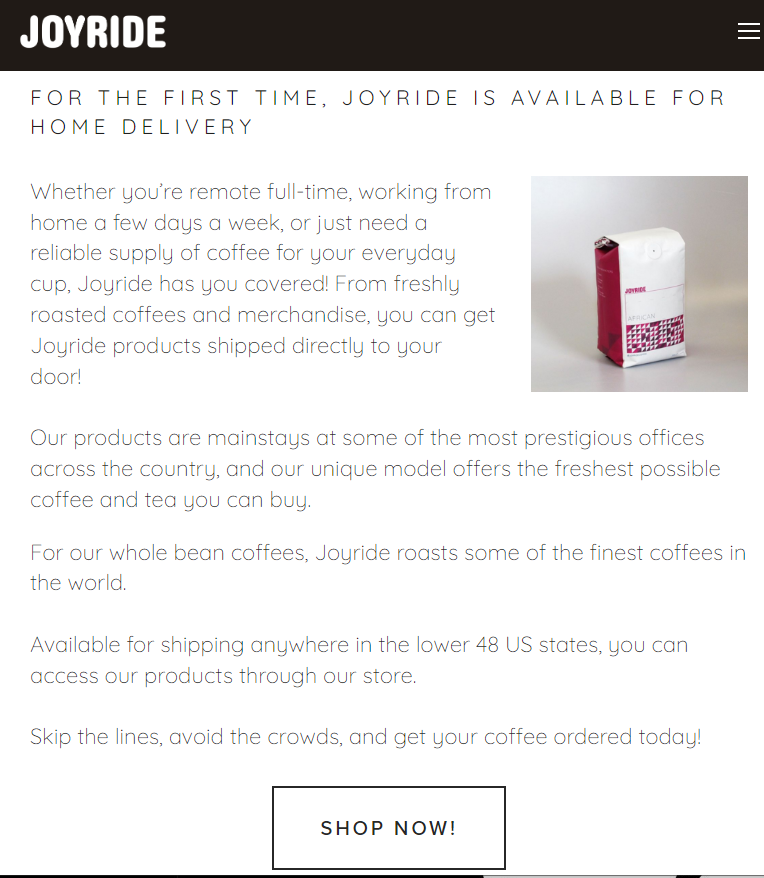
By innovating, Joyride was able to keep the business afloat and create new business opportunities.
According to global business leadership firm McKinsey, 84% of CEOs say that innovation is important to growth. They also claim that 80% of business models are at risk, which means at some point you might have to come up with new ways to keep your business relevant.
The two most important factors in adapting your business are things we’ve already spoken about: market research and your team. Continue to invest in both.
Prioritize Customer Service
For your business to grow, you need to keep customers happy so they keep using your products or services. Loyal customers mean recurring sales and more word-of-mouth recommendations. Which saves you money marketing to new customers.
To keep customers coming back, show you appreciate them. You can do this by:
Keeping in Touch
If you’re working with a small number of clients, get to know them personally. Talk to them on the phone, arrange video calls, and visit their workplace.
If you have a large customer base, email them with company news, product updates, and special offers.
For example, design platform Sketch sends its users a weekly newsletter with interesting stories and design tips:

Listening to Customers’ Needs
Again, we go back to research. Take time to understand what your customers want so you can provide it.
Rather than taking note of a customer complaint, interview that customer to understand exactly what would have made their experience better. Or interview your top customers to hear how else you can meet their needs.
Listening builds trust. And it may help your customers stick with your brand.
Being Transparent
Transparency is also crucial to building trust. Be open in all communications, inform customers of product or pricing changes, and keep the promises you make.
Say a customer is unhappy with your service. Find out why and help them troubleshoot to make improvements.
If you provide excellent customer service, most customers will do business with you again even after a mistake.
Reminding Customers of the Benefits
Keep in touch with customers to remind them what they’re getting out of your product and how it’s helping them. This works to reassure them that they made the right choice.
If you’re working with clients, share the results of your work. For instance, an online advertising agency might call a client to check-in and share important updates.
For customers using your product, email them with usage updates. For example, YouTube sends users a year in-review to help creators celebrate the success of their channel:
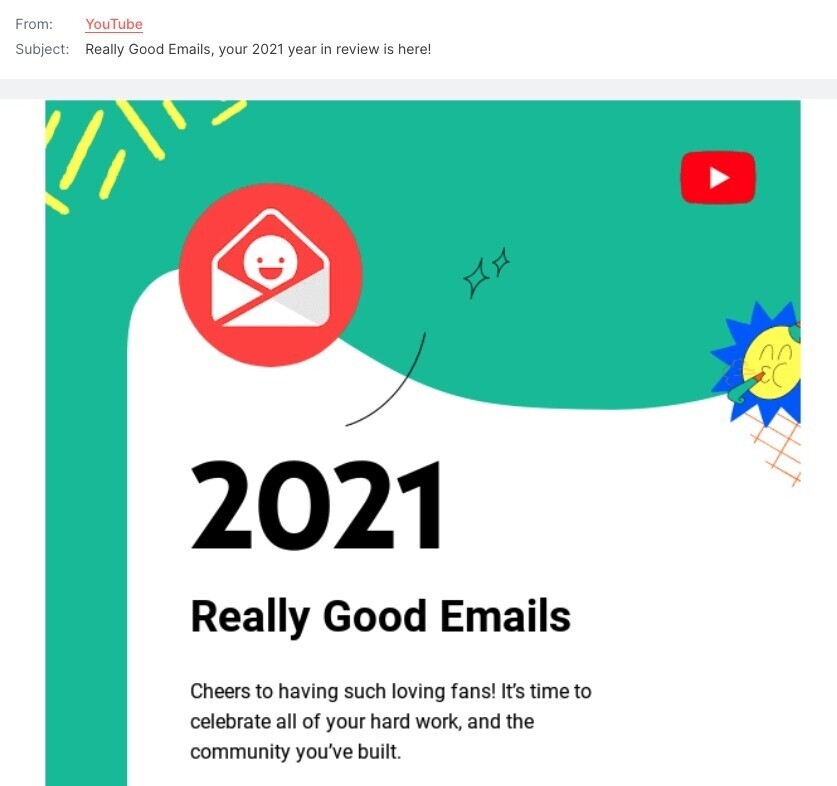
Rewarding Loyalty
Offer free goods, discounts, or special offers to customers to show that you value their loyalty. Not only does this show you care, but it also works as a way to keep your customers coming back.
Take collaboration platform Butter. It sends its customers deals on upgrade plans:
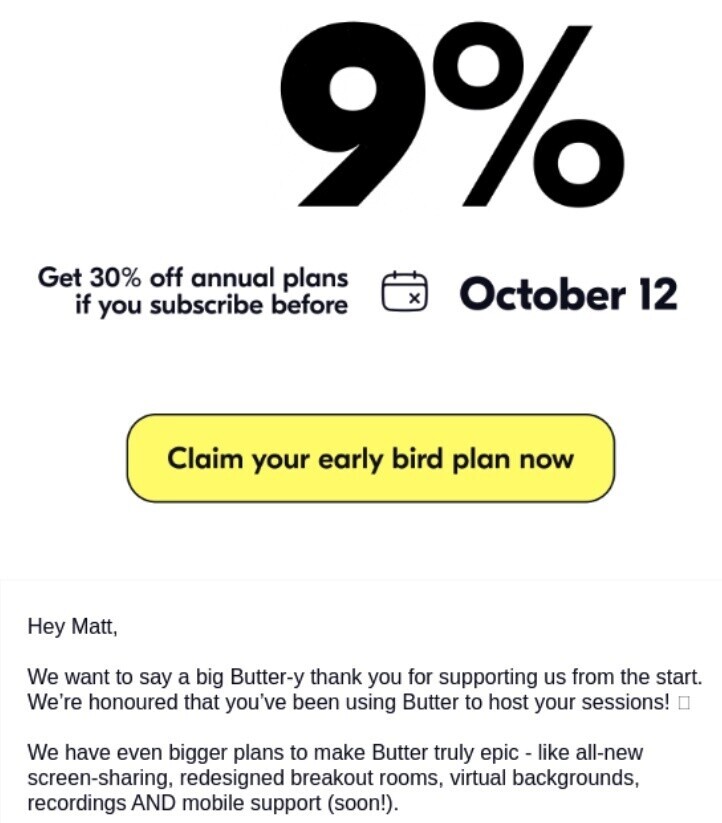
Making discounts exclusive shows customers that an offer is specifically for them. Which shows that your business appreciates existing users.
To learn more about keeping customers happy, check out these two guides:
Experiment with New Ideas to Find the Best Way to Grow
There’s no set formula for growth. Finding what works for you requires trial and error—coming up with ideas and testing them.
There’s a term for this: “growth hacking.”
Growth hacking involves experimenting across different marketing channels (e.g., email marketing, social media, or customer rewards) to find the most effective ways to grow your business. Marketers test ideas, then they do more of what works and modify or abandon what doesn’t.
It’s a proven way to quickly expand your business without investing lots of money or resources.
Email marketing tool ConvertKit is a great example. When founder Nathan Barry launched his business in 2013, he had to compete with established companies like Mailchimp and Campaign Monitor.
To grow quickly, Nathan experimented with emailing bloggers who might be interested in the product to set up Skype demos:
They loved the idea for the product, but the biggest objection was that it was too much work to switch email providers. So on a whim, I said I’d do it for them. For free.
That worked. We later called it concierge migrations and started doing that for hundreds of customers. Six months after the decision to double down, ConvertKit had grown from $1,300 per month to $5,000 per month.
After this success, the company experimented with an affiliate program that paid bloggers 30% commission for selling ConvertKit on their websites. This helped bring in thousands of new customers.
Nathan and his team then began running webinars with the bloggers in its affiliate program. To save money, they tested running the same webinar repeatedly but hosted by different bloggers so that it was shown to a different audience each time.
This grew their email list significantly—up to 50,000 subscribers in one year. And also drove a ton of new revenue.
ConvertKit is a great example of growth hacking: Experiment with growth opportunities until you find one thing that works, then repeat it. Today, the company makes $1 million a month from existing customers.
Learn different ways of testing in the guide Growth Hacking Made Easy.
Start Growing Your Business Today
Business growth is unique to your company, ambitions, and circumstances. Grand goals to become the biggest company in your industry are great. But so are modest goals like increasing sales in order to pay yourself a decent salary or to hire staff.
The most important thing is that growth is sustainable. Look at where your business is at in its lifecycle and decide where you want to take it.
Use data from your target audience and market to find areas for growth. Then run experiments to see what brings the best results.
Double down on the tactics that work. Drop or improve the tactics that don’t. Keep optimizing your growth strategy activities, and you’ll get to where you want to be.

